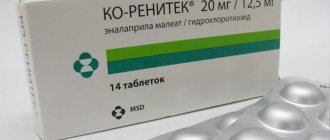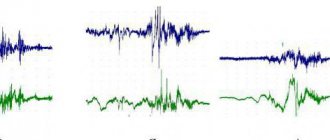Clonidine is one of the effective drugs that can cope with difficult patients. Relevant for the treatment of hypertensive disorders and periodic rises in blood pressure. This also includes glaucoma and hypertensive crisis. The official instructions for the use of Clonidine indicate that it has hypotensive, sedative and analgesic properties; it also contains information about at what pressure this medicine should be used.
Mechanism of influence on blood pressure
Taking the drug leads to suppression of the tone of the symptomatic parts of the nervous system. It is not able to affect the synthesis of catecholamines. The drug reduces the release of norepinephrine from the endings of the nervous system, using feedback from the stimulation of adrenergic receptors.
Due to this effect on the body, general vascular resistance decreases with a decrease in heart rate, resulting in a decrease in blood pressure.
The drug of choice for hypertensive crisis is Clonidine: use in patients, why it is rarely prescribed
The drug reduces blood pressure due to its inhibitory effect on the vasomotor center of the brain.
It is used for hypertension and symptomatic hypertension. Due to the pronounced sedative effect, it is now rarely prescribed, mainly to relieve a crisis. Read in this article
The use of the drug "Clonidine" in childhood is contraindicated. In the event of a critical situation when a child needs to be prescribed such a medicine, the decision on the prescription and advisability of use is made exclusively by a medical specialist.
The drug is often prescribed to people diagnosed with arterial hypertension.
The instructions for use that accompany Clonidine precisely indicate at what pressure to use it - when blood pressure is above 140/90. In such cases, this drug is usually prescribed in tablet form.
The drug is used for severe pathological conditions caused by very high blood pressure - hypertensive crises. Most often, a solution of the drug is prescribed for this.
Clonidine is also sometimes used in the treatment of open-angle glaucoma to lower eye pressure. However, its use is possible only with normal vision functioning. Used in drop form.
Directions for use and doses
If the patient has been prescribed Clonidine in tablets, it should be taken orally without chewing. To take the medicine, you do not need to use a large amount of liquid. It is best to take it during or after eating food. Regarding the dosage, in this case the doctor determines it on an individual basis. In all cases, therapy begins with minimal dosages.
In the initial stages, it is enough to drink 0.075 milligrams of the drug 3 times a day.
If the antihypertensive effect has not been achieved, the dosage should be increased by 0.035 milligrams every two days. If we talk about the treatment of an elderly person suffering from vascular sclerosis of the brain, therapy begins with a dose of 0.035 milligrams. This feature is explained by precautionary measures in order to eliminate the negative effects of the drug on the body due to increased susceptibility to the active components.
Speaking of Clonidine solution, it is injected into a vein. For one-time use, 1 milligram of the substance is diluted in 15 milligrams of sodium chloride (9%). The medicine is always administered slowly, no faster than 4 minutes.
Eye drops are used as instillations. To achieve a positive effect, according to the instructions, you should instill one drop into the eye no more than 4 times a day. If treatment is ineffective, you should consult a doctor for a combined approach to therapy.
Pharmacological features
The active ingredient in clonidine, clonidine, is an imidazoline derivative. Other medications are also synthesized from it - Galazolin, Naphthyzin, Phentolamine. Clonidine provides a quick hypotensive result, calms the central nervous system, relieves panic in alcohol syndrome, reduces the pulse rate, and relieves pain. Ophthalmologists use the power of the medication to normalize intraocular pressure (with glaucoma it can be elevated). The mechanism of action of the drug is due to the stimulation of receptors in certain parts of the brain, which inhibit reactions and weaken the conduction of impulses in the cardiovascular system.
Interaction with other medications and alcohol
If you neglect the doctor’s advice and independently increase the dose of Clonidine, the use of this medicine, if the patient has contraindications, can cause severe side effects in a person, namely:
- collapse;
- stroke;
- cardiac arrest;
- disturbances of general consciousness;
- myocardial infarction.
If the rules specified in the instructions are not followed, a person may suffer from a global decrease in blood pressure. If this drug is used simultaneously with antipsychotics that are prescribed for the treatment of a mental disorder, the sedative effect may worsen.
If you take Clonidine and any of the antidepressants, the effectiveness of the first drug will greatly decrease. Even extreme doctors do not recommend taking Clonidine and Nifedipine during the treatment process. In the future, such actions will lead to a decrease in the hypotensive effect, which will entail an increase in dosage. This can lead to side effects that are very difficult to manage.
Doctors never advise combining medications with alcohol. If you neglect these rules, simultaneous use of this drug with alcohol will lead to vascular spasms.
As a result, the patient becomes intoxicated very strongly and quickly, even with a small amount of alcohol. Afterwards he will be able to fall asleep soundly, and in the morning all events will be as if in a fog or completely forgotten. The patient will not be able to remember who was with him at the time of drinking alcohol, and under what circumstances it happened.
Recommendations
When using Clonidine as a course, you need to take into account the following features of its use:
- it is strictly contraindicated to combine with alcohol (a clonidine coma develops - the heart slows down, blood pressure drops sharply, consciousness is impaired, the patient falls into a long sleep, often with death);
- Blood pressure should be measured regularly, as clonidine's effectiveness decreases over time due to addiction;
- the inhibitory effect on the speed of motor and mental reactions is dangerous during work that requires speed of action.
It is strictly contraindicated to combine it with alcohol; a clonidine coma develops.
If you suddenly stop drinking Clonidine, a withdrawal syndrome occurs - a sudden increase in blood pressure, a crisis, trembling hands, irritability, severe headache, nausea, vomiting. Therefore, if it is necessary to switch to another drug, first reduce the single dose by a quarter of a tablet, then after 2 days by the same amount, while simultaneously taking a new medication.
Expert opinion
Alena Ariko
Expert in Cardiology
If withdrawal syndrome develops due to missing pills, you must return to Clonidine and gradually reduce the dosage. It is better not to prescribe this drug to patients with low adherence to treatment and memory disorders.
Contraindications and side effects
Clonidine is strictly prohibited to be used to treat people who suffer from the following disorders:
- Deep depression.
- Hypersensitivity to the active substance.
- Arterial hypotension.
- Atherosclerotic changes in cerebral vessels.
The medicine also cannot be prescribed to patients who are under 18 years of age, since the safety of taking it at an earlier age has not yet been fully proven. The medicine is not used as a way to lower blood pressure for pregnant women and breastfeeding mothers.
Speaking about contraindications for injections, they are as follows:
- simultaneous use with ethanol and tricyclic antidepressants;
- atrioventricular block;
- obliterating pathologies of arteries;
- sinus bradycardia with bright manifestations;
- cardiogenic shock.
It is advisable to delay taking the medicine for people who have recently experienced a myocardial infarction, as well as for those patients who suffer from chronic renal failure. If these rules are not taken into account, a person may experience side effects in the form of increased fatigue for no reason, dry mouth, general weakness, nightmares, constipation, nausea and vomiting, slow heart rate, dizziness and sexual dysfunction.
In most cases, such a reaction of the body to taking the drug is observed in the first days. If you do not make mistakes and follow the doctor’s advice, these deviations will go away on their own in 3-5 days.
Pharmacodynamics
An antihypertensive drug that acts at the level of neurohumoral regulation of vascular tone.
Taking the active ingredient clonidine lowers heart rate, upper and lower blood pressure, and the resistance of the vascular walls. Regular use of the drug helps reduce idiopathic cardiomyopathy and normalizes the functionality of the left ventricle. Shows a calming and analgesic effect. Reduces pressure inside the eye, reduces the secretion of tear fluid and improves its outflow.
What to do in case of overdose
The following signs will indicate the occurrence of an overdose:
- difficulty breathing;
- apnea;
- miosis;
- collapse;
- slowing of AV conduction;
- disturbance of consciousness;
- hypothermia;
- coma;
- early repolarization syndrome;
- decline in blood pressure;
- bradycardia;
- xerostomia.
Some patients experience surges in blood pressure. As a therapeutic measure in such situations, it is first worthwhile to urgently discontinue the use of Clonidine and immediately begin symptomatic treatment. Sodium thiosulfate is sometimes used as an antidote. If we talk about the use of hemodialysis for such purposes, it will be ineffective.
Indications for use
A constant increase in blood pressure requires the use of antihypertensive drugs.
The drug "Clonidine" is recommended to be taken in the following situations:
- complex therapy of arterial hypertension (hypertension);
- fight against hypertensive (hypertensive) crises;
- opiate drug addiction with withdrawal syndrome (as a component of complex therapy);
- primary glaucoma.
Available analogues of clonidine
Among the available analogues of Clonidine, the following drugs can be noted:
- Hemiton.
- Catapresan.
- Chlofazolin.
If these drugs have obvious similarities with Clonidine, this does not mean that they can be replaced without the knowledge of the doctor. Each product has its own contraindications, which can provoke severe deviations that are not typical for Clonidine drops, solution or tablets.
Pharmacokinetics
The antihypertensive effect manifests itself within half an hour to an hour after using Clonidine. Reaches maximum effect after two to four hours and lasts five to twelve hours. It has good absorption in the gastrointestinal tract, regardless of its use before or after meals. The limit level in the blood is one and a half to two hours after administration.
It is broken down by the liver and excreted in the urine about half of the dose taken. The half-life is 2-16 hours, in case of renal dysfunction - up to a maximum of 41 hours. Has the ability to pass into breast milk. Half of the drug is excreted in the urine, about 20% in the feces.
special instructions
As stated above, at the time of using Clonidine to lower blood pressure, it is strictly forbidden to drink any alcoholic beverages. How long the course of treatment will last always depends on the test results obtained. To avoid possible deviations and aggravation of the patient’s condition, it is necessary to stop taking the medication gradually, over 8-9 days. If the problem returns, Clonidine is resumed and gradually eliminated by replacing it with other similar means.
Speaking about intravenous administration of the drug, as a preventive measure against the occurrence of orthostatic hypotension, the patient should lie down on the couch and not get up from it for at least an hour and a half after the procedure is completely completed. If a person is treated with eye drops, but the situation does not improve in the first two days, they should be discontinued.
Before using Clonidine in each of the dosage forms, it is worth considering that a person’s mental and physical reaction will decrease.
When therapy is used for a patient whose work is directly related to the need to quickly respond to the environment, treatment is always accompanied by a hospital stay. Treatment on an outpatient basis is possible only if the person gives up his work for this time.
Video on the topic
Review of groups of drugs for hypertension:
Clonidine is a fairly toxic drug. Therefore, you need to know before using Clonidine what it is needed for and what are the contraindications to its use. It should be used exclusively as prescribed by a doctor and only in the correct dosage. With unauthorized use, not only will it not be possible to achieve the desired effect, but there is also a high probability of experiencing a whole bunch of unpleasant side effects.
The information on the MyMedNews.ru website is for reference and general information, collected from publicly available sources and cannot serve as a basis for making a decision on the use of medications in the course of treatment.
MyMedNews.ru
And we also have
Cardiomagnyl, a drug for preventing blood clots: instructions for use, price, reviews and analogues of the drug
Price
The cost of the drug Clonidine varies depending on the form of release, dosage, and manufacturer.
| Release form and dosage | Ukraine | Russia |
| Clonidine tablet 0.15 mg No. 50 | 12-20 UAH. | 20-40 rub. |
| Clonidine solution for intravenous injection 0.1 mg/ml 1 ml No. 10 | 75-85 UAH. | 150-180 rub. |
| Clonidine drops 1.3 ml | 70-80 UAH. | 150-170 rub. |
Reviews
Victoria, 68 years old Clonidine has been saving me for 17 years; it lowers my blood pressure very well. True, constantly writing out a prescription for it is not very convenient and problematic.
Ekaterina, 47 years old In the evenings, my blood pressure rises to 180 to 110. I take Clonidine regularly, 1 tablet at night. A very effective remedy.
Igor, 56 years old This medicine is an ambulance. Quickly and efficiently. The main thing is to carefully read the instructions and contraindications so that there are no problems. The only drawback is that the pressure drops too sharply. But nothing could replace it.











